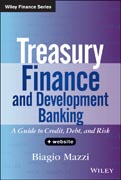
Credit and credit risk permeates every corner of the financial world. Previously credit tended to be acknowledged only when dealing with counterparty credit risk, high–yield debt or credit–linked derivatives, now it affects all things, including such fundamental concepts as assessing the present value of a future cash flow. The purpose of this book is to analyze credit from the beginning—the point at which any borrowing entity (sovereign, corporate, etc.) decides to raise capital through its treasury operation. To describe the debt management activity, the book presents examples from the development banking world which not only presents a clearer banking structure but in addition sits at the intersection of many topical issues (multi–lateral agencies, quasi–governmental entities, Emerging Markets, shrinking pool of AAA borrowers, etc.). This book covers: Curve construction (instruments, collateralization, discounting, bootstrapping) Credit and fair valuing of loans (modeling, development institutions) Emerging markets and liquidity (liquidity, credit, capital control, development) Bond pricing (credit, illiquid bonds, recovery pricing) Treasury (funding as an asset swap structure, benchmarks for borrowing/investing) Risk and asset liability management (leverage, hedging, funding risk) INDICE: List of Figures xiii List of Tables xvii Acknowledgments xix Introduction xxi I.1 Treasury, Funding, and the Reasons behind This Book xxi I.2 Funding Issues as Credit and Pricing Issues xxiii I.3 Treasury Finance and Development Banking xxv I.4 The Structure of the Book xxvi CHAPTER 1 An Introductory View to Banking, Development Banking, and Treasury 1 1.1 A Representation of the Capital Flow in a Financial Institution 2 1.2 Lending 3 1.3 Borrowing 7 1.4 Investing and ALM 10 1.5 The Basic Structure of a Traditional Financial Institution 12 1.6 Development Banking 17 CHAPTER 2 Curve Construction 21 2.1 What Do We Mean by Curve Construction? 22 2.2 The Instruments Available for Curve Construction 24 2.3 Using Multiple Instruments to Build a Curve 37 2.4 Collateralized Curve Construction 42 2.5 Numerical Example: Bootstrapping an Interest Rate Curve 55 CHAPTER 3 Credit and the Fair Valuing of Loans 67 3.1 Credit as an Asset Class 67 3.2 A Brief Overview of Credit Modeling 75 3.3 Fair Value of Loans and the Special Case of Development Institutions 88 3.4 Numerical Example: Calculating the Fair Value of a Loan 95 CHAPTER 4 Emerging Markets and Liquidity 101 4.1 The Definition of Emerging Markets 101 4.2 The Main Issues with Emerging Markets 103 4.3 Emerging Markets and Development Banking 116 4.4 Case Studies of Development Projects 122 CHAPTER 5 Bond Pricing 127 5.1 What Is a Bond? 127 5.2 A Few Fundamental Concepts of the Bond World 129 5.3 Expressing Credit Explicitly When Pricing a Bond 138 5.4 Illiquid Bonds 150 5.5 Numerical Example: Estimating the Coupon of an Emerging Market Debt Instrument 164 CHAPTER 6 Treasury Revisited 171 6.1 Funding as an Asset Swap Structure 171 6.2 Funding Level Targets 179 6.3 The Fundamental Differences between Investment Banking and Development Banking 187 6.4 Benchmarks for Borrowing and Investing 189 CHAPTER 7 Risk and Asset Liability Management 207 7.1 The Issue of Leverage 208 7.2 Hedging 210 7.3 Managing Risk Related to Financial Observables 224 7.4 Funding Risk 242 CHAPTER 8 Conclusion 261 8.1 Credit Is Everywhere 261 8.2 The Fundamental Steps to Borrowing, Lending, and Investing: A Summary 263 APPENDIX A Implying Zero Rates from FX Forward Quotes 269 APPENDIX B CDS Spreads and Default Probabilities 271 APPENDIX C Modeling the Credit–Driven Prepayment Option of a Loan 273 APPENDIX D The Relation between Macaulay and Modified Durations 275 APPENDIX E The Impact of Discounting on an Asset Swap Spread 277 APPENDIX F Replication Leading to Risk–Neutral Probabilities 279 References 283 About the Web Site 289 Index 293
- ISBN: 978-1-118-72912-0
- Editorial: John Wiley & Sons
- Encuadernacion: Cartoné
- Páginas: 336
- Fecha Publicación: 21/11/2013
- Nº Volúmenes: 1
- Idioma: Inglés
